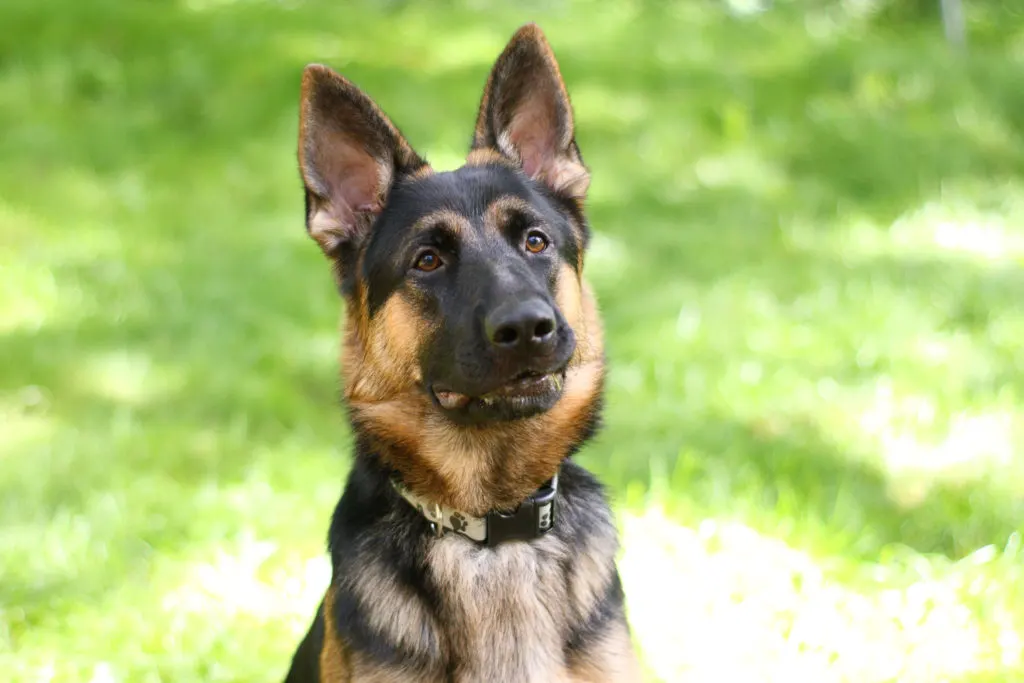
If you own a German Shepherd, then you know that they can be extremely expressive through their body language.
Some body language is quite obvious – a tail wagging like crazy accompanied by excited licks is a good indication that your dog is really happy.
However, there are times when your GSD may be giving off more subtle cues that are difficult to interpret by the untrained observer.
Also, not all GSD body language is what it may seem, so we’ve put together this guide to better assist you with understanding just what your German Shepherd is trying to tell you and others in his presence through his body movements and expressions.
Click Here to Jump to a Section
Eye Movements and Gestures
Some of the most subtle, and sometimes not so subtle ways that a German Shepherd will communicate to other people and animals are through their eyes.
Most cues that a German Shepherd will indicate though their eyes have to do with stress, anxiety, and precipitation to biting.
It’s important that if you have a GSD, or even come across someone else’s, that you are familiar with what their eyes are indicating.
Having this knowledge will give you the opportunity to remedy a stressful situation for the dog, or even prevent yourself or another from getting bitten.
Slow Blinking and Squinty Eyes
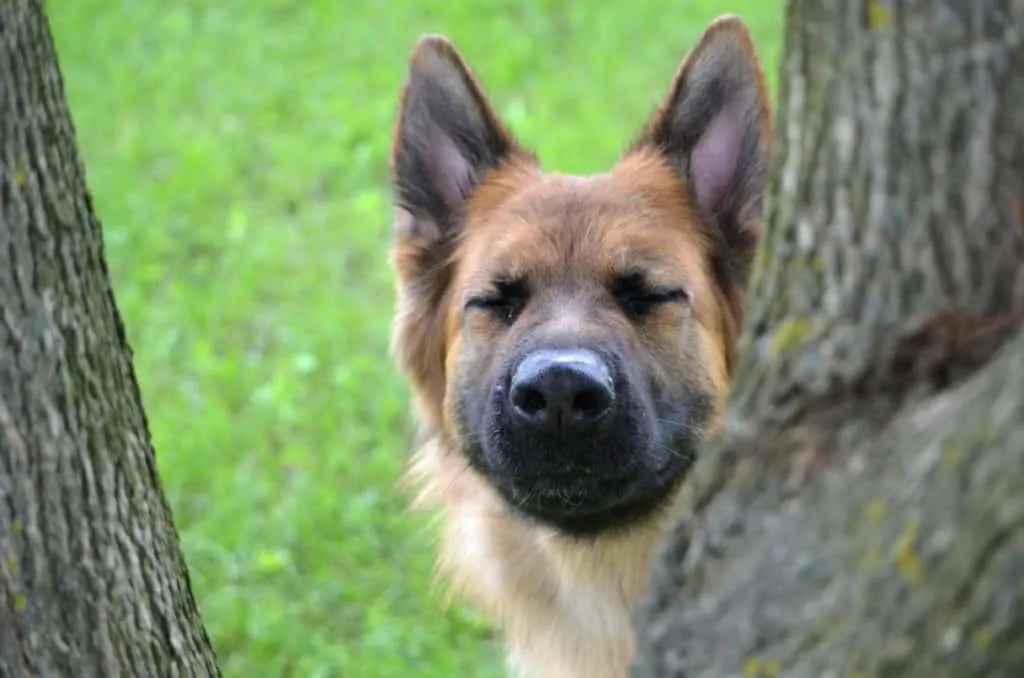
If your GSD is expressing himself in this way, it can mean two different things. It can either mean that your dog is seeking your attention, or it can also mean that he is trying to get others around him to relax.
If you do observe this behavior in a GSD, especially when around other people or animals – take note.
It’s actually a stress signal, and means that the GSD is not too comfortable with the actions of the people or animals in his presence.
Eyes Looking Away from a Trigger
You may notice at times that your GSD focuses his look away from, rather than towards an event that you would normally expect him to be looking at.
This “event” could be another dog, person, or even an inanimate object like a loud vacuum cleaner or blender.
In this instance, your GSD is actively avoiding the trigger or source of the action, and he is trying to remain calm and deflect it.
What he is essentially “saying” in this instance is “I don’t want a fight.”
However, it’s very important to not misread this signal, as doing so could be dangerous. Do not treat a GSD that is looking away as a dog that is safe to approach.
Any dog that is giving this signal is on the cusp of feeling overwhelmed, and a dog that feels overwhelmed can change very quickly from timid to aggressive. It’s the classic fight or flight scenario.
“Whale Eye”
You’ll notice this when a German Shepherd is looking in a different direction than his head is pointed. You will see what resembles a large crescent moon shape in the white of his eyes.
What this indicates is either fear, stress, or anxiety. What a GSD is saying here is “give me space.”
If you notice this, you need to ask yourself what you can do to change the situation to accommodate the GSD.
This may mean either removing your dog from the situation, or if it’s not your dog, then calmly removing yourself from the situation is what’s called for.
Dilation of Pupils out of Context to Light
Just like in humans, if a dog is in low light conditions, it’s natural for his pupils to be dilated.
However, the sign to look for here is if your GSD’s eyes are dilated in a brightly lit environment, such as outside on a sunny day or in a brightly lit room.
This can be a sign of stress, anxiety, or over-arousal.
Take note: If a GSD’s eyes are very frequently dilated out of context to lighting conditions, then this can also be a sign of a medical issue that needs further inquiry.
Staring or Intense Focus
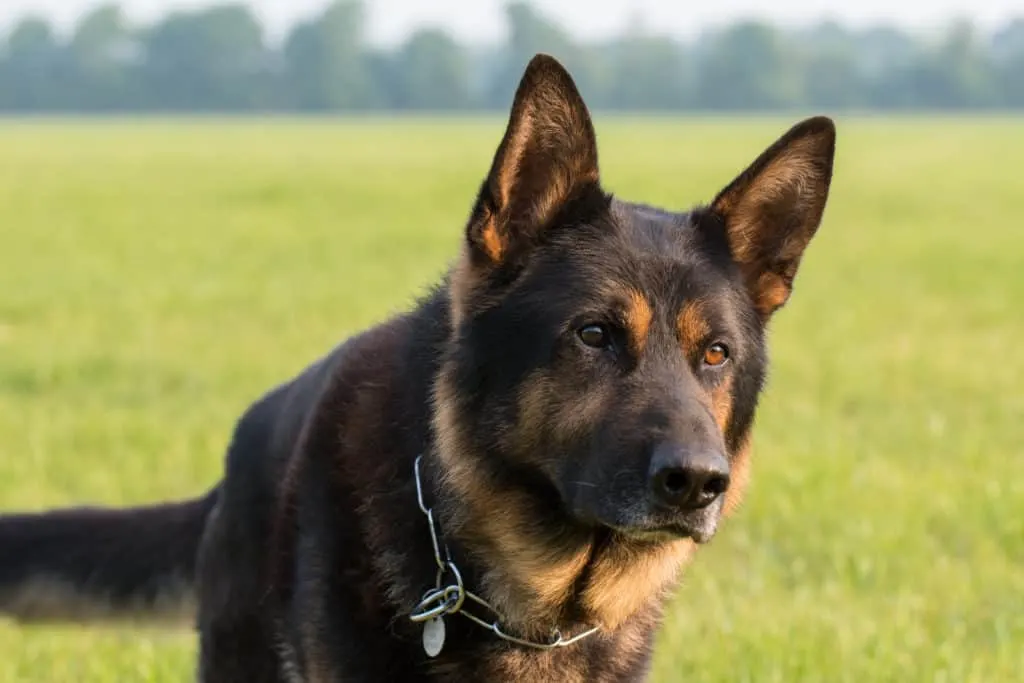
If you see this in a German Shepherd, it’s time to take notice and pay very close attention to what is going on with the dog.
This is a huge red flag, and it can often mean that the dog’s next move is to bite. Staring and intense focus can be the only warning that you get.
A GSD who is staring is experiencing stress, fear, and he is saying “GO AWAY NOW!”
The dog’s stare will not always be directed at a person or another dog, and it will sometimes be directed towards an item that the dog is guarding.
For example, if you’ve ever gotten too close to a dog with a bone, you’ve probably heard him growl while staring not at you, but at the bone.
Darting Eyes
This is a step above and beyond a dog just checking out his environment.
For example, when out for a regular walk in a familiar environment, it’s natural for your dog to be taking in all of his surroundings.
It’s natural for your dog to be curious of his surroundings and checking out other animals and people that he comes across.
Distinguish this normal eye behavior from darting eyes.
In the instance where a dog is darting his eyes around, you will notice that there is something more going on than just observation of his surroundings.
This is a sign that the dog is stressed, and it will most often occur in new environments like the veterinarian’s office, or when out for a walk in a brand new environment.
The dog will be checking out everything in a hyper-vigilant manner, and not focusing too long on any particular thing. He will be visibly tensed.
If this happens, rather when it happens, this is your cue to see what you can do to change the environment or just basically slow things down.
If this happens when out walking, then it’s time to just stop for a minute or two. Sometimes this alone will be enough to just de-escalate whatever is overwhelming your dog.
Another example would be if you are on a planned outing with your dog, like taking him to the beach, or some other location with many other people and/or animals present.
While on the one hand, it is important to socialize your German Shepherd and acclimate him to new environments as much as possible, it is also important that you do so in a manner that does not stress your dog out.
This will require some discretion on your part. You know your dog best.
If you feel that your dog is more tensed than he would normally be in such a situation, then it is better to err on the side of caution and perhaps a change of plans is in order.
You can always come back to revisit the situation on a different day. Dogs, just like people, have “on” days and “off” days.
Ear Movements and Gestures
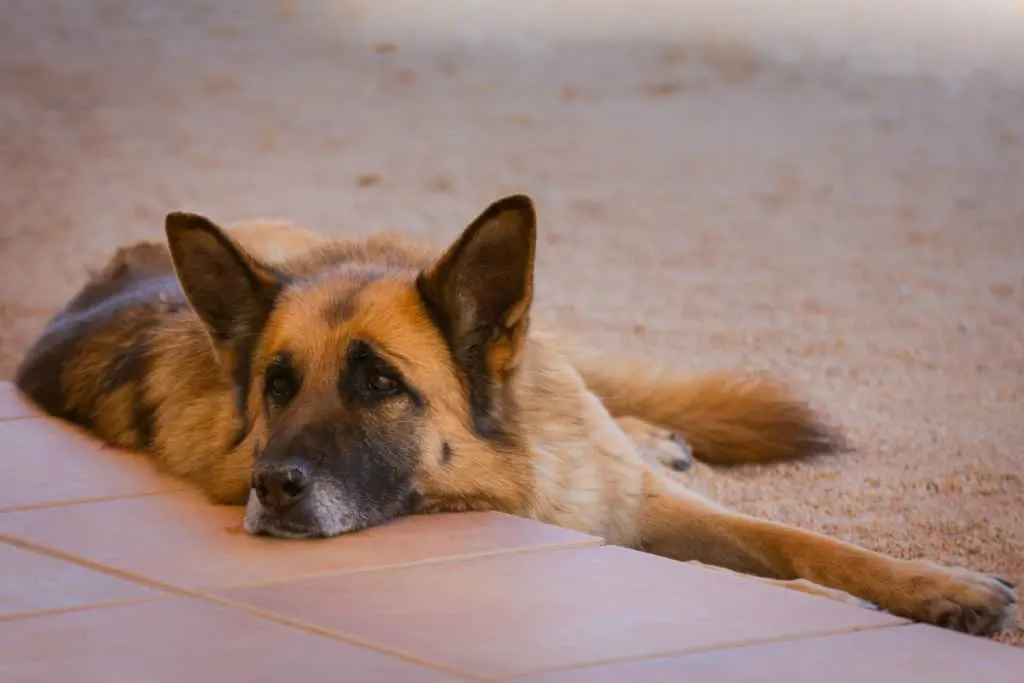
German Shepherds have an acute auditory sense. It’s how they were bred, and they need to hear well to stay ever-vigilant when guarding herds and property.
Their ears are large and rigid so as to allow for maximum sensitivity to subtle noises.
The shape of their ears also offers a distinct advantage to you, as it is possible to notice even the most subtle of cues just based on what a GSD is doing with his ears.
Let’s now take a look at some German Shepherd ear behaviors and how to translate them.
Relaxed Ears
This is just what it appears to be. If your German Shepherd’s ears are just kind of relaxed and flopped back, then your dog is feeling the same way – relaxed.
Pinned Back Ears
If your GSD’s ears are more pinned back, almost in a rigid way, then this is a sign to take note of. Pinned back ears are a sign of your dog being fearful or anxious.
Ears Forward
Forward tilted ears are a sign that your GSD is alert and listening. Ears tilted in this way are also indicative that your dog is feeling confident.
When your GSD is feeling confident, you will notice it much as you would in a person – there is a certain indescribable demeanor that is just apparent. Forward positioned ears are just part of this larger picture.
Ears Actively Changing Direction
When your GSD’s ears are tilting in a few different directions, this is a sign that he is listening to multiple things at the same time.
Your GSD has the ability to focus his attention on several different sounds at the same time, and will often be looking in one direction with his ears tilting in different directions at the same time.
You will most often notice this in situations when your GSD is outdoors and there may be a number of external stimuli happening at the same time – cars, other animals, people, etc.
When you see this, it’s a good idea for you to scan your surroundings so that you can get in tune with anything that might cause any stress to your dog, and so that you are not met with any unwelcome surprises.
Mouth and Tongue Movements
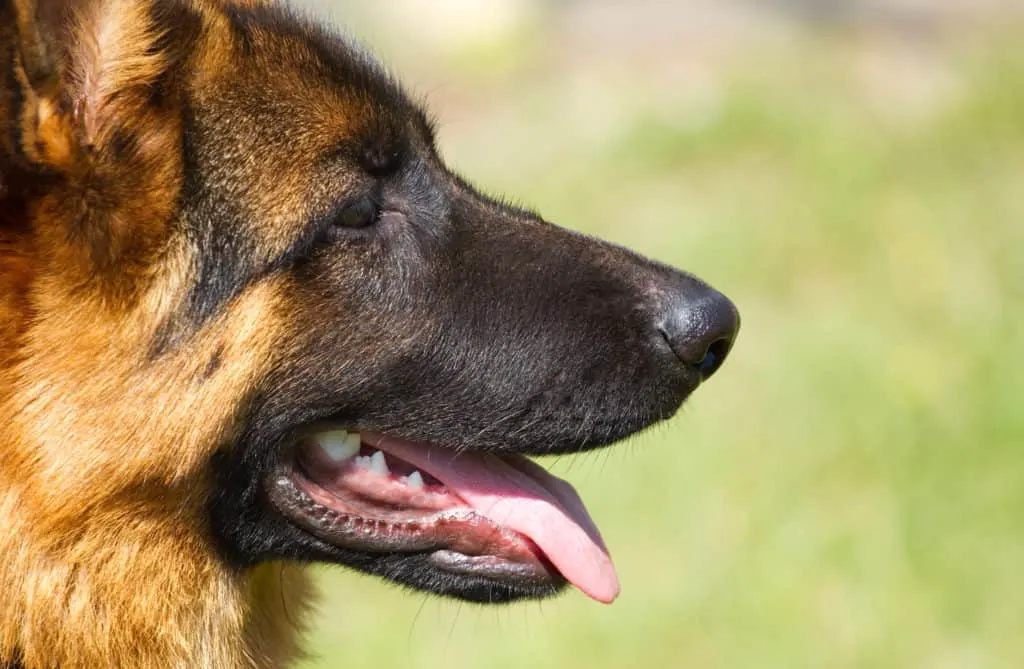
Deciphering how a dog is feeling by actions involving his mouth is a bit tricky, as the same postures can often have dual opposite meanings.
Here we will explain all of the possible meanings, but it is very important that you familiarize yourself with your dog to learn how he is feeling through your own observation.
Again, nobody knows your dog better than you. You are the person best situated to interpret your dog’s behavior.
Use these guidelines as a reference point, and apply your personal knowledge about your dog to understand what he may be feeling.
Mouth Open
A German Shepherd with an open mouth can be feeling either stress or relaxation.
The biggest thing to notice with open mouth behavior is change. For example, did the dog’s mouth go from partly open to suddenly closed?
This would be an example of a sort of stilling behavior from your dog, as you will notice that when this happens, the rest of his body will still at the same time.
This is a sign that something has caught his attention, and if you look around, you will likely see what he is focusing on.
Mouth Going from Closed to Open
If your dog’s mouth goes from closed to open, then this can indicate stress. Again, take a look around. Listen closely. See if you can pick up on what may be causing your dog stress.
Snarling or Raising of the Lip
When a dog’s mouth takes these positions, it is a sign that they are uncomfortable or feeling unsettled – they are essentially telling you to “back off.”
If your German Shepherd’s mouth takes a snarled position, or if he is raising his lip, then this is a very likely sign that he is getting ready to snap at the person whom they are doing this towards, or even bite them.
Take this sign very seriously and think about what you can do to change the situation.
In most cases, this will mean that if the dog is being petted, to slowly and calmly stop the petting action. Then give the dog some space.
There is also the possibility that if your dog has his lip curled up, almost like a smile, that he is not getting ready to act in an aggressive manner, but is instead being submissive.
People often refer to this as their dog “smiling.” While this cannot be equated to a human smile, because the dog is not expressing joy or happiness, he is not expressing aggression either.
Instead, he is relaxed and expressing submission. This “grin” will be accompanied by relaxed ears and an overall calm demeanor.
Panting
Many people often assume that when their dog is panting, he must just be hot or recovering from exercise. While this may be the case, all instances of your dog panting need to be taken into context.
This means that if your dog has just been retrieving a ball on a hot day and then begins panting, it’s likely that he is, in fact, hot and tired. He is panting to release excess heat from his body.
However, if your dog is panting and there are no apparent external reasons for why he should be doing this, then take note. This is a sure sign of either stress, fear, over-arousal, or excitement.
If this is the case, your dog’s panting will likely be accompanied by drool. Some dogs drool excessively from stress.
You may well notice this when you are taking your dog to the veterinarian. I know that the first time I noticed this in a dog, I thought that the dog was feeling carsick.
However, I later learned that this was actually a stress reaction, as the dog was keenly aware that he was going for a car ride to the veterinarian’s office.
In instances where a dog is panting, also pay attention to the shape of its tongue to decipher whether or not the panting is stress-related.
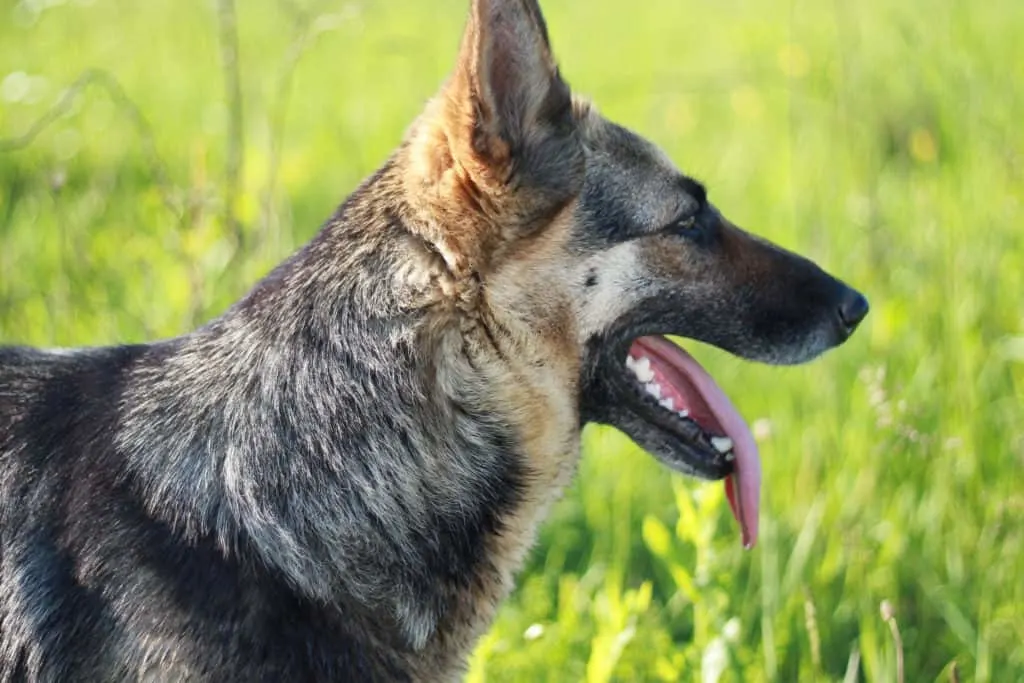
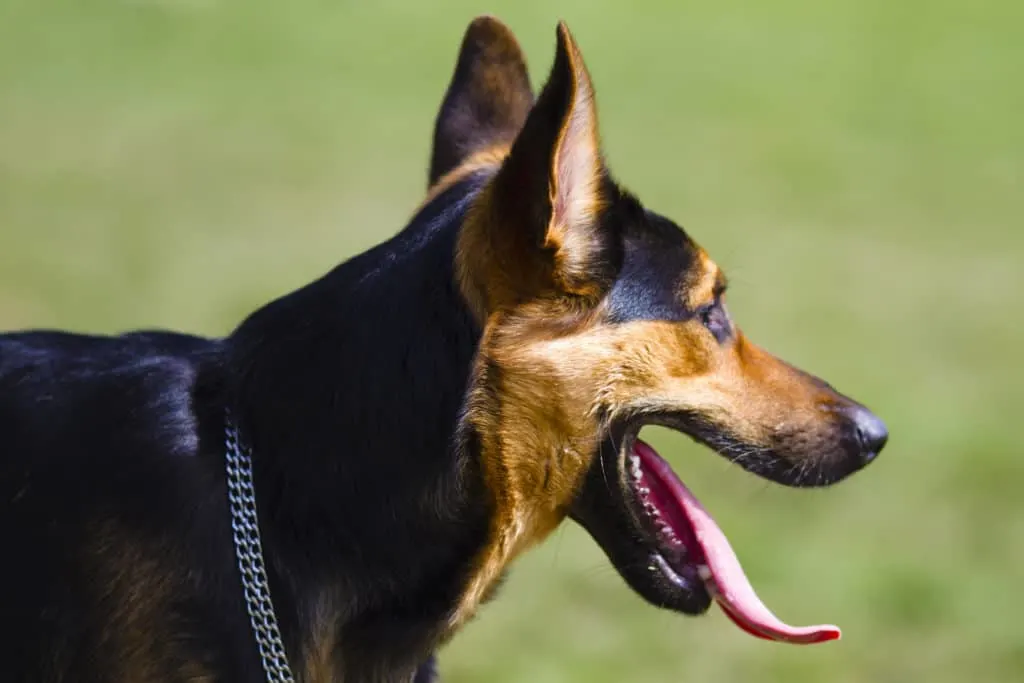
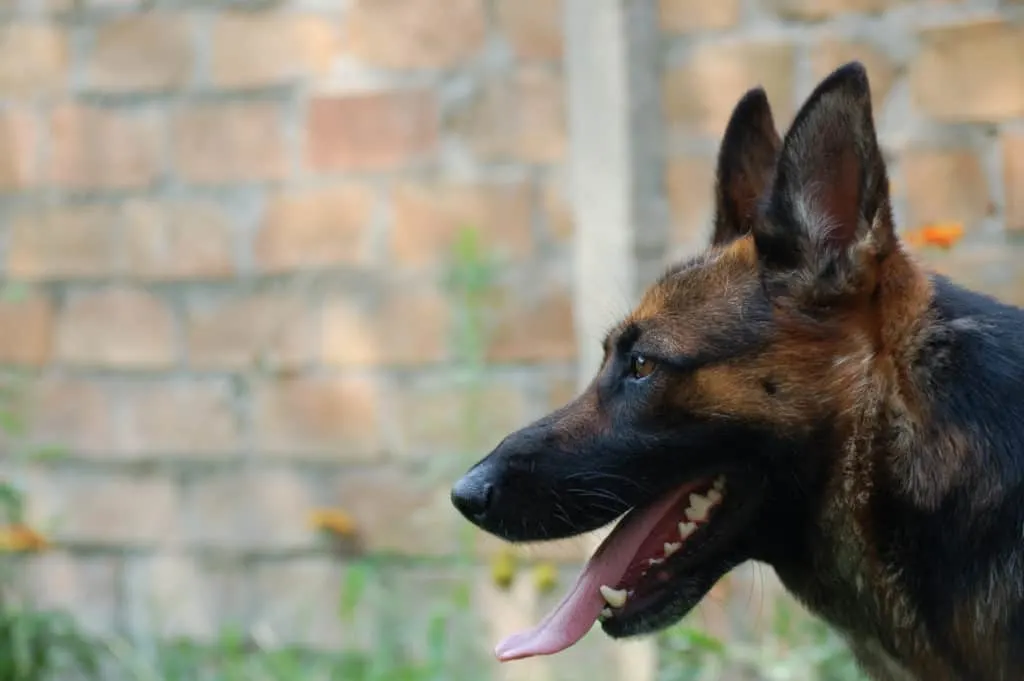
In an overheated dog, the tongue will just hang and bob up and down with his breath. However, if panting is due to stress, then the dog will have a “spatulate” tongue.
This refers to when a dog’s tongue will take on an almost spatula shape, as it will have a concave curve across its width. It is very easy to distinguish from a normal hanging tongue provided that you know what you are looking for.
Yawning
Yawns can mean a few things for a GSD. First, and the feeling that we most easily associate with a yawn, is that the dog is tired. In this respect, dogs are the same as humans – they will yawn when they are tired.
However, when your GSD yawns it may also be a sign of stress, conflict, or anxiety.
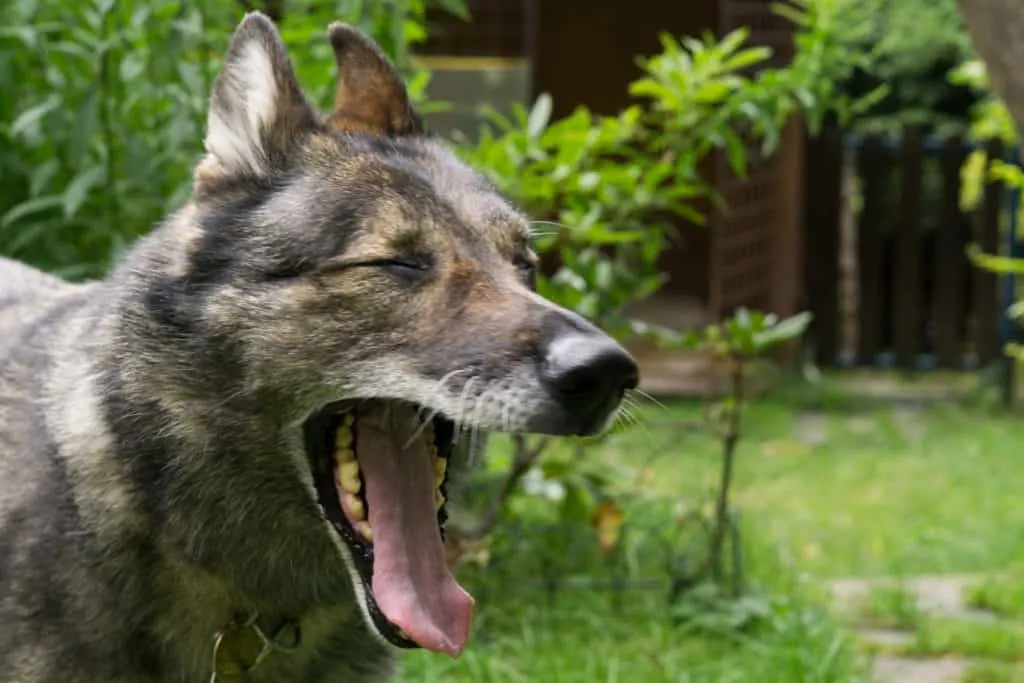
Yawning can be your dog’s way of telling you that things are getting a bit overwhelming, and that there needs to be some type of a change in the situation to calm things down a little bit.
An easy way to tell why your dog is yawning is again to just pay attention to the surrounding circumstances.
If you are in a familiar place, such as your home, and you are winding down your evening as usual, then your dog yawning likely means that he is just as tired as you are and is ready for bed.
But, if you are somewhere unfamiliar in the middle of the day, and perhaps in the company of new people or animals, then a yawn from your dog is most likely a sign that things are getting a little bit too stressful for him.
Stress-related yawns in GSDs also tend to be much longer and more exaggerated than a regular yawn due to being tired.
Some German Shepherds will also vocalize when they yawn, but this is dependent on your particular dog’s personality.
It’s very important that you pay attention to your dog giving these cues because in large part they are ignored, simply because people most people do not know what to look for.
But once you recognize your dog’s particular way of yawning, then it will be very easy for you to pick up on in the future. You will know when you are in a situation with your dog that needs to be addressed or just left alone.
Licking Lips and Flicking of the Tongue
If your GSD is licking his lips, this a stress-related sign. The licks may just be tiny and quick flicks of the tongue, or they may present as full-fledged licks along the sides of his mouth.
If the lip-licking is stress-related, it means that your dog is trying to tell you:
- “Leave me alone.”
- “I need space.”
- “I’m feeling pressure from you.”
- “I’m feeling worried.”
- “Back off.”
- “I’m confused and don’t know what you want from me.”
As with most other behavioral signals, context here is also very important.
You can be sure that if you are holding a steak in front of your dog’s face, then him licking his lips is far from stress-related!
On the other hand, if there is no steak present, and you notice that your dog is either licking his lips in a very pronounced manner, or if he is just doing a succession of quicker licks continuously – then it’s time to pay closer attention to the behavior.
Evaluate the circumstances, and ask yourself if there is anything in the environment or if the environment itself may be the cause of your dog’s stress-related lip licking. Say that ten times fast. Really – try it!
Licking for Appeasement
You may notice that your German Shepherd is fond of licking you. This can be a source of frustration for some dog owners, and they do their best to get their dog to stop this behavior by correcting the dog in a negative manner.
However, trying to correct this behavior in a negative way will only cause the issue to become more problematic.
This is because the purpose behind appeasement licking is just that – to appease you. So the more that you try and correct this behavior, the odds are that it will only get worse.
By appeasement licking, your dog is simply trying to tell you that he wants you to accept him. He is eager to bond with you and this is one of the ways that he instinctually knows to show you his intention.
Keep in mind that not all licks are appeasement licks.
For example, if you have just come in from a run and are covered in sweat, your dog may just be enjoying the taste of the salt from the sweat on your skin.
Audible Huff of Sigh
When you hear this from your dog, he’s most likely doing it for the same reasons that you may find yourself doing the same.
You may find that your dog does this subsequent to a stressful event – it’s a sigh of relief.
You can use this behavior to your advantage when identifying things that may cause your GSD stress.
For example, if you take your dog to an unfamiliar place and your dog lets out a huff or a sigh when leaving the location, then you can be pretty sure that your dog was in a stressful state while at that place.
You will now have identified where not to take your dog in the future.
Hair
Aside from just being shed in copious amounts all over the place, the hair on your German Shepherd can actually be very useful in giving you visual cues as to what he is feeling internally.
Let’s now take a closer look at what it means when your German Shepherd’s hair is positioned in a number of different ways.
Hair Standing on End
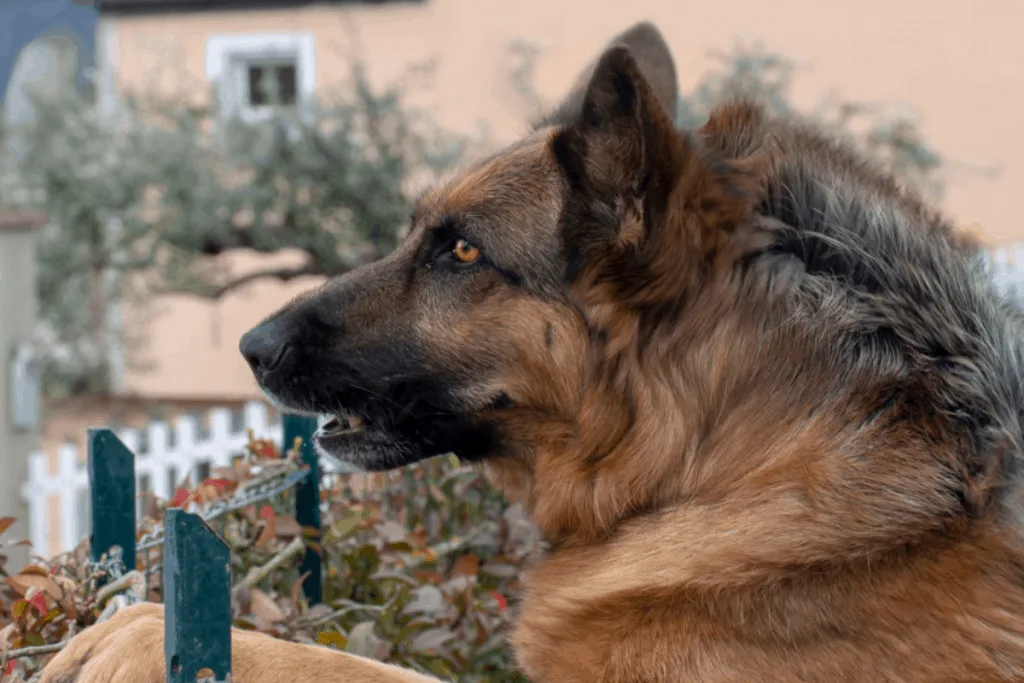
When your German Shepherd’s hair stands on end, this is called “piloerection” or “hackles.”
When most people witness this happening with a GSD, they automatically think that the dog is in a heightened aggressive state.
While this can certainly be true, it is also the case that piloerection can occur if the dog is in fear of something, aroused, or if he is sensing impending conflict – usually with another dog.
Depending on the dog, the hair that is standing on end can be above only the withers of the dog (at the base of the neck and above the shoulders), down his whole back, or just in portions along his back.
Take a look at what’s going on around your dog when this happens and it will give you a better idea about why his hair is standing on end.
Hair Shedding
While it is completely normal for a German Shepherd to shed – a lot – there can be instances where a GSD is shedding much more than usual when he is undergoing stress or fear.

A picture-perfect example of this is evidenced all over your veterinarian’s office.
You have likely noticed that there is usually an overabundance of your dog’s hair strewn about the room when the vet is examining your dog – this is because your GSD is in a heightened state of stress.
You may also notice this as you are waiting in the lobby to enter the examination room.
Next time you take your GSD to the vet’s office, run your hand along his back as you are waiting.
If your dog is fearful of the vet (as many “ferocious” German Shepherds are!) you will notice that each stroke along your dog’s fur results in an abnormal amount of hair ending up in your hand.
Dander
Dander is essentially dandruff. It is composed of tiny, sometimes microscopic flecks of skin.
When dander is related to stress, it will come on suddenly – similar to stress-related shedding. Dander can also be brought about by fear.
It’s important to understand how quickly this can happen.
We often associate dandruff as a sign of dry skin. But with your German Shepherd, dander will just appear as if out of nowhere if it is due to a stress or fear response.
Tail Movements
When surmising how your German Shepherd is feeling by observing his tail, make sure that your observation begins from the base of the tail.
Since GSDs’ tails can sometimes be rather bushy, especially with a long-haired variety, it can be difficult to ascertain exactly what the tail is doing when your are looking for subtle indicators.
By looking at the base you will be able to more easily detect a subtle raise or drop in the tail.
Wagging tail
When your GSD is wagging his tail, do not make the mistake of believing that this is always an indicator of a happy dog.
Here, it’s important once again to look at context. If you are in a situation with your dog that would make it seem unlikely that he is happy, yet he is wagging his tail, this is more likely a sign of stress than joy.
Tail Tucked Between Legs
More often than not, a German Shepherd with his tail tucked will be indicating that he is feeling fear, submission, or that he is just feeling generally uncomfortable with whatever situation he’s in.
The angle of how the tail is tucked is a good indicator of the intensity of the GSD’s feeling. The deeper it is hooked and tucked under the dog, the more intense the feeling of fear, submission, or general discomfort with the situation.
Low Hanging Tail
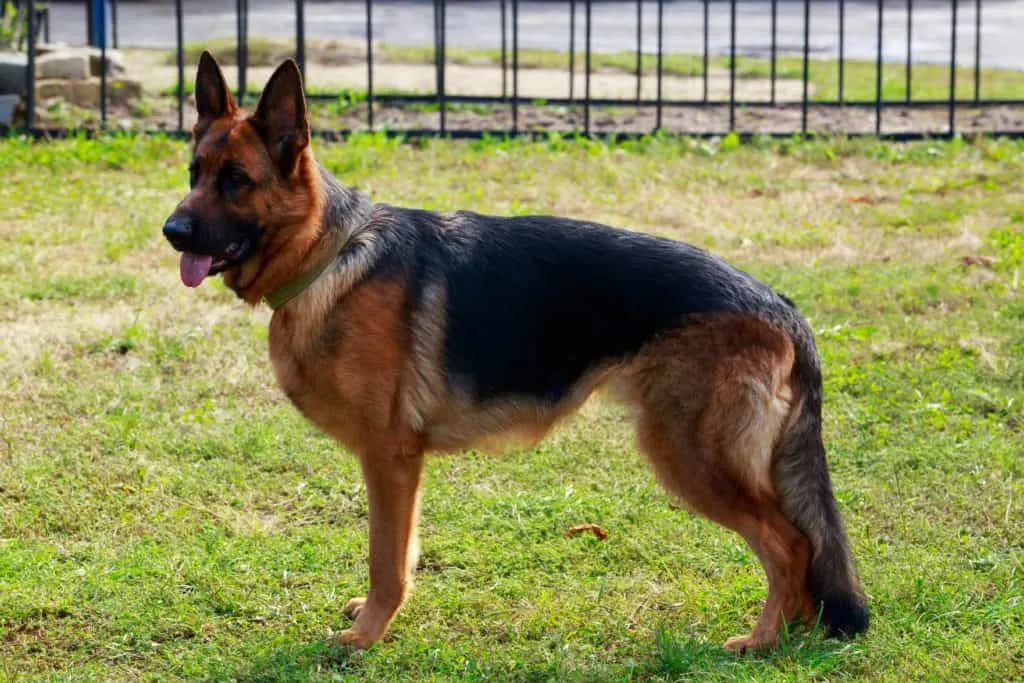
When a GSD has his tail hanging low, this is a good indicator that he is feeling relaxed. You will notice in such a case that your dog’s overall demeanor will also be generally relaxed.
With a GSD, a low hanging tail doesn’t necessarily mean that it will be hanging straight down. Looking at the base of the tail is helpful here to differentiate between a slightly tucked tail and a low-hanging tail.
If it is slightly tucked, then there will be more of an immediate downward slope from the base, vs. a low-hanging tail, which will be indicated by a more gradual or straight line from the base of the tail.
High Positioned Tail
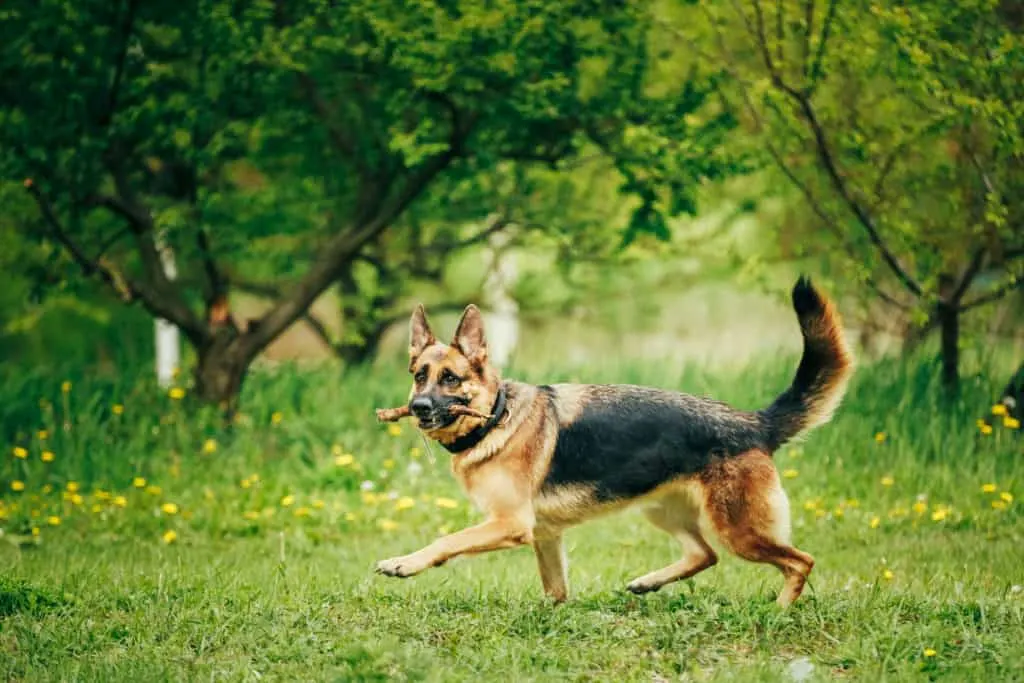
A German Shepherd who’s tail is positioned up high can mean a few different things:
- Aggression
- Arousal
- Eagerness to play
- Eagerness to breed
Regardless of the reason that your GSD may be holding his tail in a high position, you can be sure that it is a sign of some type of interest.
To determine exactly what his interest is, just take a look around.
If there are other male dogs present, then be on the lookout for aggression or play.
And if there are other female dogs present, then it is more likely that your GSD is indicating that he is aroused and perhaps eager to breed.
Middle Positioned Tail
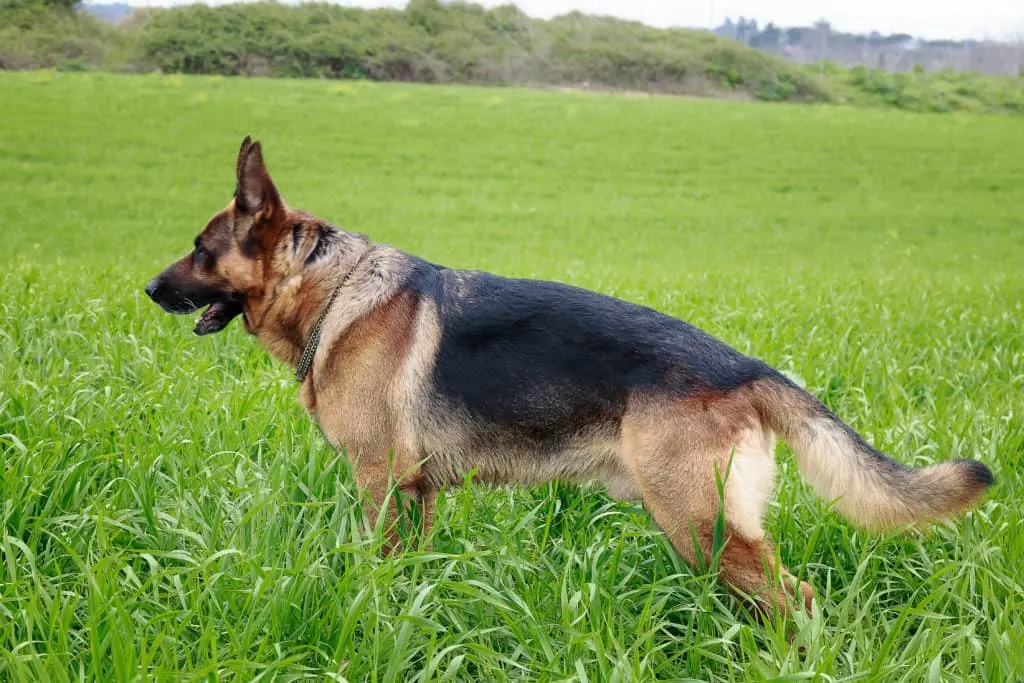
A middle-positioned tail can be an ambiguity for a German Shepherd. It can mean mostly the same things as a high-positioned tail – fear, arousal, aggression, play.
Here, the surrounding context is often the only way to tell exactly what is going on with a GSD internally.
A tail in this position is often an indication that the dog is in-between states, and just isn’t as of yet showing how he will be responding to a situation.
So again, it’s important to look at the big picture, as this can be a sign that a GSD is just assessing a situation and hasn’t yet committed to a response.
Slow Wagging Tail
A GSD who is slowly wagging his tail is likely showing calm, although it can be a sign of slight fear.
Similar to the middle-positioned tail, a slow wagging tail can indicate that the dog is unsure of a situation, bordering on being fearful.
Fast Wagging Tail
If your German Shepherd is wagging his tail quickly, then this can mean that he is:
- Aroused
- Aggressive
- Wanting to play
As previously mentioned, it imperative that you don’t mistake a wagging tail for happiness.
All too often this mistake is made, and a German Shepherd that is wagging its tail has actually bitten someone, as the wagging was actually a misinterpreted sign of aggression.
Be especially careful with young children around. Television and incorrect popular thought often engrain the misconception that a wagging tail means a happy dog.
Children have a habit of throwing caution to the wind when it comes to approaching something that they associate with fun – and a big and cuddly GSD who’s wagging his tail is irresistible to just about any small child.
Tail That Suddenly Stops Wagging
If your GSD was wagging his tail and then suddenly stops, then it’s time to pay close attention.
This behavior is a sure indication that there has been a sudden change within your dog’s emotions.
The change could just be as simple as something piquing his curiosity – perhaps a squirrel he noticed outside of the window.
However, a tail that suddenly stops wagging can also indicate a potentially dangerous situation, especially if the German Shepherd in question is interacting with someone specifically.
It will be a sign that something in the interaction has changed, and not for the better.
So stay aware of this, and should it happen, take a calm approach and remove your dog from the interaction.
Final Thoughts
Remember that all German Shepherd behavior is on a spectrum. There is no definite point that can be ascribed to any one behavior.
Use your knowledge about your particular dog to evaluate just where on the spectrum of any given behavior that your dog is situated.
A great reference guide is put out by the British Small Animal Veterinary Association.
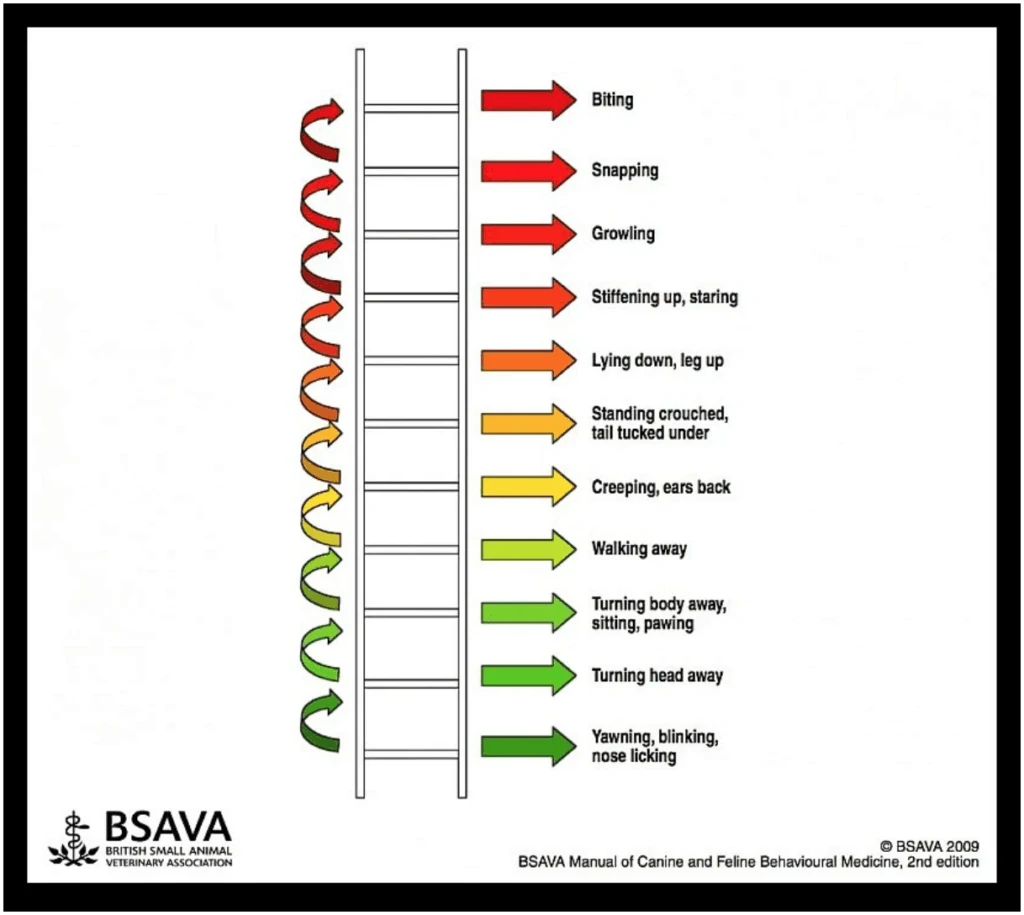
While it contains no exact thresholds, as these are impossible to discern when speaking about any breed in general terms, it is a very accurate visual representation of behavior escalation in German Shepherds.
Remember that when evaluating your German Shepherd’s body language to always look at the frequency of the cues, along with how repetitive they are, and observe whether they are in combination with other cues as well.
Use your understanding to better communicate with your German Shepherd, and to know when to exercise caution around others.
